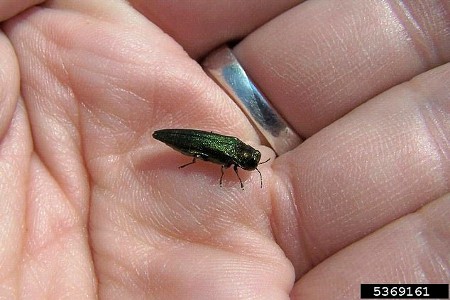June 9, 2020 – Gene mapping and gene therapy can help both plants and people based on these two late-breaking stories this week.
In the first, we learned about scientists at Queen Mary University of London working on mapping the genome of ash trees to identify why some species defeat the Emerald Ash Borer, an invasive insect that has killed millions of trees around the planet. And in the second. we learned about a clinical trial by German researchers that are using gene therapy and an engineered virus to reverse colour blindness.
Gene Mapping and the Emerald Ash Borer
This tiny flying insect which originates from northern China and Korea has devastated forests in Russia and North America. In its native East Asia habitat ash trees have adapted to resist surviving the annual infestations. But not so for North American and Russian ash trees which have no built-in defenses to withstand the assault.
In 2002 the Emerald Ash Borer leaped across the Pacific Ocean to North America on the back of global trade. The insects life cycle in cool climates allowed its larvae and pupae to over winter inside the bark of trees before adults emerged in early summer to mate and lay their eggs. When winters were very cold it was a deterrent, but winters have been getting warmer meaning more of the larvae and pupae survive. So this migration facilitated by wooden skids made from ash and used for shipping goods from East Asia around the world has now given the Emerald Ash Borer new environments in which to spread.
The research done at Queen Mary University of London and the Royal Botanic Gardens in Kew is revealing the chemistry of ash species that exist in Asia and Europe and show resistance to the insect. Scientists have identified 53 genes responsible for producing chemicals found only in resistant trees.
There are two likely approaches to treatment. The first would be to introduce these genes into North American and Russian native ash species so that they too can become more resistant. The second would be to replace the native trees with the species of ash that have the 53 genes on board. That would mean introducing European and Manchurian Ash trees into North America and Russian forests.
It is interesting that the research on the Emerald Ash Borer is occurring in the United Kingdom which so far has been spared from the insect infestation. Stated one of the key UK researchers, “It’s good news for the future of our native ash trees and our work to protect those trees showing tolerance to ash dieback.” It will also be good news to Russia and North America ash to have found a genetic solution to stop the insect from doing further damage to critical ash forests to maintain tree biodiversity and the proliferation of natural carbon sinks to combat climate change.

Gene Therapy and Colour Blindness
If you are colour blind then the world is a monochrome place like the movie town, Pleasantville. In that fictitious world before the advent of colour television, everything was black and white and shades of grey. But not seeing in technicolour, something that affects approximately 1 in 12 men and 1 in 200 women, goes by the name achromatopsia and is caused for some by a defective gene designated CNGA3. Mutations of this particular gene are associated with one-third of all of those who cannot see colours.
Using an engineered virus as a transport mechanism, researchers at the Ludwig Maximilian University of Munich and University Hospital Tübingen in Germany, have developed an experimental therapy that is designed to insert a healthy CNGA3 gene into the cone cells of the eyes of those who are colour blind. When the virus delivers the normal gene it begins to replicate it replacing the defective one.
In a recent clinical trial involving eight men and one woman, after a few weeks, all recipients showed improvements to cone photoreceptors allowing them to see colours. The experimental treatment was administered to only one eye. It would be interesting to know if the eye that could see in colour compensated for the eye that could not. There were no reported complications for any participants.
From this limited trial result, the researchers believe there is enough evidence to attempt the gene therapy with children suffering from achromatopsia. Administering it earlier would allow the brain to adapt and grow neural connections and receptors to eliminate colour blindness in its entirety. The research, therefore, plans a follow-up trial exclusively with children.









